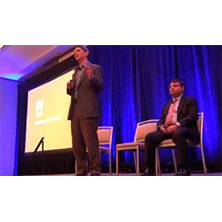“Customers are establishing new buying behaviors with brands.”
“Industry lines are blurring with new forms of competition.”
“Regulatory and risk concerns are growing every day.”
With these dramatic changes, aligning IT legacy systems with modern needs is a huge challenge for organizations.
This challenge is due largely to the inherent struggle of legacy systems to innovate and tap new business opportunities. When organizations manage each of their legacy systems separately, this contributes to incremental complexity in operations and IT decision-making. As this gap widens, organizations are left with reduced efficiency, increased frustration, and higher operational cost.

To combat these issues, organizations are now thinking deeply about legacy application modernization.
Modernization strategies need to fit their unique business needs and circumstances but also:
- Improve existing structure
- Increase application reusability
- Enhance flexibility
- Boost performance
- Reduce TCO
The challenge, is how to do so successfully and cost-effectively.
Application modernization isn’t an easy job, and failing to modernize correctly can put a huge burden on the overall cost of a project, and cause damage to business continuity.
So, before you proceed on an application modernization journey, it is critical to understand the principles that guide your initiative. We’ve devised a thorough plan to help you assess your current environment and identify all the factors that may need review.
Identify existing challenges
- Analyze how your legacy application is impacting your existing and future business needs
- Identify the potential risk to business continuity you may face with your aging system
- Consider the operational risks and unexpected cost of application failure
- Determine continuing operating, maintenance, and replacement costs
- Strategize to eliminate redundancy by removing overly expensive and obsolete applications
Create a strategic roadmap
- Define whether you want to maintain your application as it is or completely transform it with full awareness of the potential perils and benefits
- Explore modernization platforms, technologies, and infrastructures
- Consider the re-hosting opportunity (cloud) and potential to reduce cost in the long-run
- Analyze existing deployed code and understand how it interacts with customer data, specific business logic, or third party applications
- Identify which applications must be eliminated or improved
- Recognize process improvement areas to further simplify the application
- Identify core business application components that are proven and can be reused to significantly lower risk, cost, and time to market
- Simplify your technology profile and integration points to establish a more agile application portfolio
Execute modernization strategy
- Re-architecture and repurpose legacy applications if needed
- Enable SOA (Service-Oriented Architecture) to make reusing and connecting the core application across your organization easy
- Bring into practice industry-leading application development frameworks covering application development, delivery, tools, and SaaS, PaaS, and IaaS
- Build, customize and integrate, while addressing business agility, growth enablement, and standardization requirements
- Automate process to reduce the extra effort and ambiguity of custom coding
- Review testing quality and integrity
- Deploy
Maintenance and support
- Adopt a proactive application lifecycle management approach to ensure positive performance and greater success
- Eliminate all possible manual processes to reduce dependency and inconsistency
- Fully utilize your resources
Managing cost
Modernizing an application can be much costlier and more disruptive than expected, because of hidden true costs and the risks associated with updating an existing application. Sometimes performance, output, and scalability issues, coupled with high resource consumption can put a modernized application at a much higher cost than expected.
There you have it; all the necessary steps to complete a successful application modernization project, while keeping cost down.
Now that we’ve given you the preliminary step-by-step, your business will need expert advice and assistance to make your modernization journey a smooth one. Taking the time to research and choose the right modernization partner is one of the most important factors of a successful implementation. After all, a modernization is only as good as its ability to continuously evolve and address changing business needs.

Balaji has spent over 18 years in the IT Services Industry. With an experience encompassing Services and Product Marketing, he has successfully managed globally distributed Marketing and Product teams. He’s an analytical marketer with strong understanding and experience across marketing strategy, demand generation, field marketing, technology partner marketing, account based marketing, digital marketing, event management, analysis and third party relationship, PR/Media, people management, etc.








